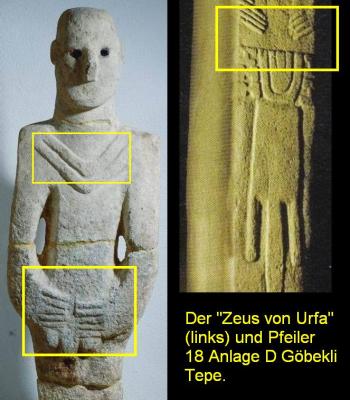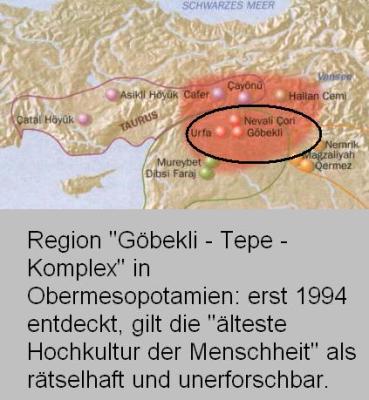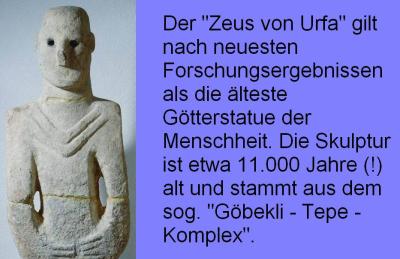Göbekli Tepe, the Garden of Eden
Göbekli Tepe is a site in Turkey, just north of the Syrian border, a bit south of the Euphrates river, and about 15 km northeast of the town Sanilurfa in Turkey. The site is on top of a small hill (Göbekli Tepe means "hill with a navel" or "hill with a belly" in Turkish). The site was examined in the early 1960's by archeologists from the University of Chicago, and the University of Istanbul.
Göbeklitepe Höyüğü, Şanlıurfa'da bir tepe üzerine kurulu Cilalı Taş Devrinden kalma, dünyanın bilinen en eski dini yapılar topluluğu.
1963'te fark edilen dokuz hektarlık kazı bölgesinin önemi yaklaşık 10 yıl kadar önce tarlasını karasabanla sürerken bulduğu oymalı taşı müzeye götüren Mahmut Kılıç sayesinde anlaşılabilmiştir.
Şanlıurfa'ya 20 km'lik bir mesafede, Örencik Köyü yakınlarındadır. 1995 yılında ilk kez Alman Arkeoloji Enstitüsü ve Şanlıurfa Müze Müdürlüğü'nün işbirliğiyle kazı çalışmalarına başlandı. Kazılar Alman arkeolog Doç. Dr. Klaus Schmidt’in başkanlığında yürütülmekte olup, her yıl eylül ve ekim aylarında 10 haftalık bir süreç içinde yapılmaktadır.
Günümüze kadar yapılan kazılar sonucunda bir Cilalı Taş Devri yerleşimi olduğu anlaşıldı. Tarihi MÖ 11 binyıllarına uzanan, tapınma amaçlı törensel alanlara ait mimari kalıntılar, dikili taşlar ve üzerinde kabartmalı yabani hayvan ve bitki figürlerinin bulunduğu taşlar günyüzüne çıkartıldı. Bölgenin önemi ise günyüzüne çıkarılan en büyük tapınma alanını barındırmasıdır.
Siehe dazu topaktuell und ausführlich:
http://kulturschocksteinzeit.twoday.net/stories/goebekli-tepe-alle-daten-alle-fakten/

It was part of a larger survey of the region, and at the time, it was dismissed as the remains of a medieval monastery. Three decades later, a local shepherd noticed some oddly shaped stones on the ground. The news reached the curators of the local museum in Sanilurfa, about 50 km away, and eventually to the government ministry in charge of antiquities.

They contacted the German Archeological Institute in Istanbul. As a consequence, Klaus Schmidt re-examined the site in 1994, and noted that various artifacts found at the site were similar to those found at nearby sites which had been carbon dated to as early as 9,000 B.C. Excavation began the next year, with a German-Turkish team.

The Göbekli site is spread over an area of about 22 acres on a sort of plateau among the hills. There is a gently rounded mound, about 300 meters in diameter and 15 meters high, on the plateau. From the site there is an almost uninterrupted view of the horizon on all sides. To the north is the Taurus range, to the east the Karadağ. In the south, the Harran plain stretches away to Syria. To the west is a series of ridges over which the road from Orencik traverses, to reach the site.
Barely an acre of the site has been excavated so far. The site consists of a number of stone buildings and walls which date to the period between 9,000 BC and 8,000 BC, although the beginning of the earliest construction appears to be as old as 11,000 BC or 12,000 BC. This is certainly before the beginning of agriculture anywhere in the world, before the invention of the wheel, the creation of pottery. Göbekli Tepe was built by a hunting/gathering society. Twelve thousand years ago, the region was ecologically richer than it is today, and probably supported large numbers of animals. Klaus Schmidt, the chief archeologist of Göbekli Tepe speculates that hunter/gatherer bands or tribes met during part of the year, lived near the site in animal skin tents, hunted local game, and built the complex over several decades. A large number of flint arrowheads found near the site support this idea. Bones of wild animals are found in great profusion, many of them bearing marks indicating that the animals were butchered. All the bones are from wild animals, mostly gazelles, but also boar, red deer, wild sheep, as well as several species of birds.
Look here:
http://oppermann.twoday.net/stories/asasara-kultur-bandkeramiker-und-indogermanen/
http://altekulturen.twoday.net/stories/goebekli-tepe-die-medien-und-das-internet-unsinn-ohne-ende/
Göbeklitepe Höyüğü, Şanlıurfa'da bir tepe üzerine kurulu Cilalı Taş Devrinden kalma, dünyanın bilinen en eski dini yapılar topluluğu.
1963'te fark edilen dokuz hektarlık kazı bölgesinin önemi yaklaşık 10 yıl kadar önce tarlasını karasabanla sürerken bulduğu oymalı taşı müzeye götüren Mahmut Kılıç sayesinde anlaşılabilmiştir.
Şanlıurfa'ya 20 km'lik bir mesafede, Örencik Köyü yakınlarındadır. 1995 yılında ilk kez Alman Arkeoloji Enstitüsü ve Şanlıurfa Müze Müdürlüğü'nün işbirliğiyle kazı çalışmalarına başlandı. Kazılar Alman arkeolog Doç. Dr. Klaus Schmidt’in başkanlığında yürütülmekte olup, her yıl eylül ve ekim aylarında 10 haftalık bir süreç içinde yapılmaktadır.
Günümüze kadar yapılan kazılar sonucunda bir Cilalı Taş Devri yerleşimi olduğu anlaşıldı. Tarihi MÖ 11 binyıllarına uzanan, tapınma amaçlı törensel alanlara ait mimari kalıntılar, dikili taşlar ve üzerinde kabartmalı yabani hayvan ve bitki figürlerinin bulunduğu taşlar günyüzüne çıkartıldı. Bölgenin önemi ise günyüzüne çıkarılan en büyük tapınma alanını barındırmasıdır.
Siehe dazu topaktuell und ausführlich:
http://kulturschocksteinzeit.twoday.net/stories/goebekli-tepe-alle-daten-alle-fakten/

It was part of a larger survey of the region, and at the time, it was dismissed as the remains of a medieval monastery. Three decades later, a local shepherd noticed some oddly shaped stones on the ground. The news reached the curators of the local museum in Sanilurfa, about 50 km away, and eventually to the government ministry in charge of antiquities.

They contacted the German Archeological Institute in Istanbul. As a consequence, Klaus Schmidt re-examined the site in 1994, and noted that various artifacts found at the site were similar to those found at nearby sites which had been carbon dated to as early as 9,000 B.C. Excavation began the next year, with a German-Turkish team.

The Göbekli site is spread over an area of about 22 acres on a sort of plateau among the hills. There is a gently rounded mound, about 300 meters in diameter and 15 meters high, on the plateau. From the site there is an almost uninterrupted view of the horizon on all sides. To the north is the Taurus range, to the east the Karadağ. In the south, the Harran plain stretches away to Syria. To the west is a series of ridges over which the road from Orencik traverses, to reach the site.
Barely an acre of the site has been excavated so far. The site consists of a number of stone buildings and walls which date to the period between 9,000 BC and 8,000 BC, although the beginning of the earliest construction appears to be as old as 11,000 BC or 12,000 BC. This is certainly before the beginning of agriculture anywhere in the world, before the invention of the wheel, the creation of pottery. Göbekli Tepe was built by a hunting/gathering society. Twelve thousand years ago, the region was ecologically richer than it is today, and probably supported large numbers of animals. Klaus Schmidt, the chief archeologist of Göbekli Tepe speculates that hunter/gatherer bands or tribes met during part of the year, lived near the site in animal skin tents, hunted local game, and built the complex over several decades. A large number of flint arrowheads found near the site support this idea. Bones of wild animals are found in great profusion, many of them bearing marks indicating that the animals were butchered. All the bones are from wild animals, mostly gazelles, but also boar, red deer, wild sheep, as well as several species of birds.
Look here:
http://oppermann.twoday.net/stories/asasara-kultur-bandkeramiker-und-indogermanen/
http://altekulturen.twoday.net/stories/goebekli-tepe-die-medien-und-das-internet-unsinn-ohne-ende/
rosenberger - 31. Okt, 14:20
